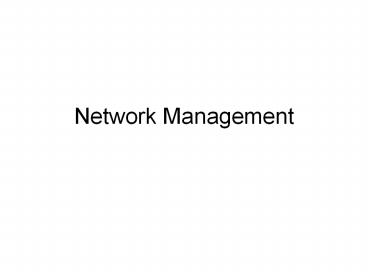Network Management - PowerPoint PPT Presentation
Title:
Network Management
Description:
Fault is usually indicated by failure to operate correctly or ... Reconfigure or modify the network to minimize the effect of removing the failed component(s) ... – PowerPoint PPT presentation
Number of Views:13
Avg rating:3.0/5.0
Title: Network Management
1
Network Management
2
Network Management Requirements
- Fault Management
- Accounting Management
- Configuration and Name Management
- Performance Management
- Security Management
3
Fault Management
- A fault is an abnormal condition that requires
management attention (or action) to repair - Fault is usually indicated by failure to operate
correctly or by excessive errors - Users expect quick and reliable resolution
4
Responding to Faults
- When faults occur, it is critical to quickly
- Determine exactly where the fault is
- Isolate the rest of the network from the failure
so that it can continue to function without
interference - Reconfigure or modify the network to minimize the
effect of removing the failed component(s) - Repair or replace the failed components to
restore the network to its initial state
5
Accounting Management
- Reasons for accounting management
- Internal chargebacks on network use
- User(s) may be abusing access privileges and
burdening the network at the expense of other
users - Users may be making inefficient use of the
network, and the network - The network manager is in a better position to
plan for network growth if user activity is known
in sufficient detail.
6
Configuration Management
- Concerned with
- initializing a network and grace-fully shutting
down part or all of the network - maintaining, adding, and updating the
relationships among components and the status of
components themselves during network operation
7
Performance Management
- Issues of concern to the network manager include
- What is the level of capacity utilization?
- Is there excessive traffic?
- Has throughput been reduced to unacceptable
levels? - Are there bottlenecks?
- Is response time increasing?
- Network managers need performance statistics to
help them plan, manage, and maintain large
networks
8
Security Management
- Concerned with
- generating, distributing, and storing encryption
keys - monitoring and controlling access to networks
- access to all or part of the network management
information - collection, storage, and examination of audit
records and security logs
9
Network Management Systems
- Collection of tools for network monitoring and
control, integrated in these ways - A single user-friendly operator interface for
performing most or all network management tasks - A minimal amount of separate equipment
- consists of incremental hardware and software
additions implemented among existing network
components
10
Network Management System Architecture
11
Components of the NMS
- All nodes run the Network Management Entity (NME)
software - Network control host or manager runs the Network
Management Application (NMA) - Other nodes are considered agents
12
Network Management Entity
- Collection of software contained in each network
node, devoted to the network management task - Performs the following tasks
- Collect statistics on communications and
network-related activities. - Store statistics locally
- Respond to commands from the network control
center - Send messages to NCC when local conditions
undergo a significant change
13
Indicators Reported by Network Monitors
- Service Parameters
- Availability
- Response Time
- Accuracy and Integrity
- Efficiency Parameters
- Througput
- Polling
- Utilization
14
Simple Network ManagementProtocol (SNMP)
- Network Management Model
- Management station
- Management agent
- Management information base
- Network management protocol
15
Role of SNMP
16
Protocol Specification
- Transmission of a message
- Receipt of a message
- Variable bindings
17
SNMPv2
- Released in 1992, revised in 1996
- Addressed functional deficiencies in SNMP
- Accommodates decentralized network management
- Improves efficiency of data transfer
18
SNMPv3
- Released in 1998, addressed security deficiencies
in SNMP and SNMPv2 - Does not provide a complete SNMP capability
defines an overall SNMP architecture and a set of
security capabilities for use with SNMPv2 - Provides three important services
authentication, privacy, and access control































